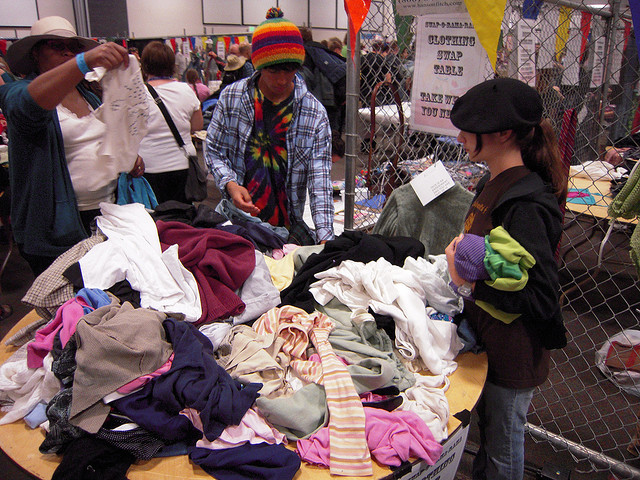
I shopped hard. I shopped often. I hunted deals.
If I found a great fitting t-shirt, convinced by marketing that there would never be another better fitting t-shirt and this one would disappear next season, I bought three of them. Repeat said concept with great fitting jeans, shorts, etc. Everything was my favorite until another favorite came along and pushed previous favorites to the back of my overflowing drawers.
Some garments never left the closet more than once as I deemed them somehow imperfect or not so flattering upon deeper reflection.
One day I had enough. I was simply tired of the overflow and feeling badly about creating it. So I went on a fast.
I gave myself a year off from clothes shopping. I vowed to wear everything I owned. If something truly didn’t fit it could go to a friend. Things that just might be less than flattering had to be worn at least once more. Oddly, those items elicited the most compliments, but, I digress.
Reactions to my clothing fast were startling. When I mentioned it in a yoga class during the morning new-yoga-clothes-admiration time it was met with stone silence. One woman said, “But, what are you going to do?” I assumed she meant how was I going to cover my tender hide in public and I assured her that I had lots more clothes. She replied, “I mean for satisfaction.” This was an honest revelation for me.
Yes, we shop for satisfaction, not need. But I can be satisfied by lots more meaningful things and do not need more clothes to prove my value.
Months into my clothing fast I started researching the clothing industry. I started to understand what fast fashion means. I learned that the fashion industry is the second biggest global polluter just after oil and gas. How on earth can this be acceptable?
Why have I been worried about every pesticide on my peach and feeling bad about any plastic water bottle while I own three pairs of white jeans made from non-organic cotton? How did this never make it to the upper levels of my eco-awareness?
As for the idea of giving excess to charity: too many garments flood other countries and screw up their local economy of clothing manufacturing and too many get to the landfill and stay forever.
More research and I read about the deaths in Rana Plaza which made me understand how the clothing industry has no inflation where every other product does. I understand that when I get a bargain on yet another pair of cute shorts, some one else paid the price—it might be a cotton farmer in India, a child that never sees its mother in Cambodia, a polluted river or an injured worker’s family. I live in the richest country in the world. I am employed. I can afford to pay an appropriate amount for quality garments. Those people can’t afford my excess.
I refuse to participate. Ahimsa, I will do no harm in Sanskrit. At least not for a new dress and a pair of strappy sandals.
The next step is harder. As my clothing fast comes to an end there will be some eventual needs. I still need to look like a professional at work and wear shoes in public.
There are some clothing companies that embody the philosophies of fair trade and eco-acceptable manufacturing. There are organic cotton farmers and there are some people who can sew (I aspire to be one of them). So my new shopping rules are these:
1. Buy what you need to cover your hide and maintain social appropriateness, not to satisfy some unmet desire. Know the difference.
2. When you do buy, you must wear that item at least 30 times. This means it must be durable, washable, not overly trendy and represents a serious commitment to a garment. Be sure.
3. Buy directly from the companies that truly address your beliefs. For me that is Prana, Patagonia, SOS Texas and a handful of small businesses some of which are even made in the US. I can pay them more if I buy less.
4. Don’t give up what you got. Wear it all. Get it altered or repaired if need be. Some local person might still know how to do that or maybe you can figure out your mother’s dusty sewing machine.
5. Talk about it. Nobody likes this topic but they like their new shoes. They like getting a bargain at the outlet mall. But, maybe you can light that little spark. If you say it nicely.
As for me, I don’t mind anymore. I love what I have. I have new appreciation for how my quality garments are made. Some human somewhere with great skill sewed it for me. I can only thank them by wearing it out.
~
Relephant:
John Oliver’s 17 Minute Takedown of Wasteful Fast Fashion.
Eco-Fashion vs. Fast Fashion.
Relephant bonus: 97 percent of all cotton grown in India is Monsanto-owned GMO cotton but this company is making a change:
~
Author: Wendy Hauschildt
Editor: Katarina Tavčar
Photo: PROPip R. Lagenta/Flickr











Read 3 comments and reply